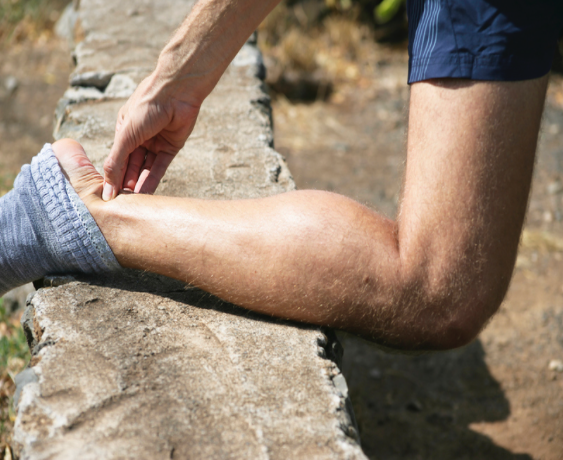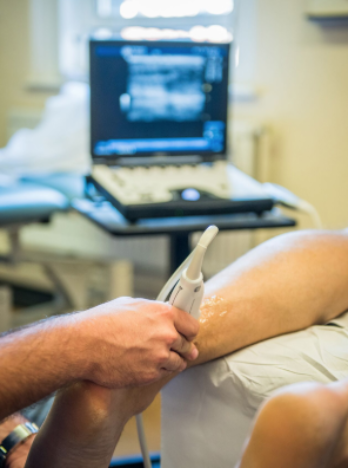Achilles tendon pain is very common among recreational and elite sportspeople. But it is also common among sedentary individuals. The Achilles is the largest tendon in the body and attaches the calf muscle to the heel bone. It is thought that up to 50% of runners will experience pain in their tendon at some point in their life.
A tendon is a tough band of fibrous connective tissue that connects a muscle to the bone and is capable of withstanding very high forces. Running is a series of hops and our Achilles tendon acts like a spring – it stores energy and returns energy. The stiffer the muscle-spring, the greater the energy stored. This translates into better speed and economy of effort and more importantly a pain free tendon!
At Complete Physio we see hundreds of Achilles tendon problems every year. This varies from a mild tendinopathy which may only take a few days or weeks to settle to a complete rupture which requires months of rehabilitation.
The first thing to getting you out of pain and back to full function is getting with the correct diagnosis. We are experts in the diagnosis of tendon complaints but here are a few top tips in the art of self-diagnosis.
Self diagnosis Top 5 tips: Is your pain coming from the tendon?
We always advise that you get properly assessed by an experienced physiotherapist whenever possible. All our physiotherapists at Complete have extensive knowledge and experience of treating Achilles tendon problems.
1. Is your tendon stiff and sore in the morning or after you have been sitting for a while? Is it particularly painful going down stairs in the morning and the seems to warm up. YES/NO
2. Does it ease up with gentle activity? For example, does it seem to warm up after 5-20 minutes of walking or if you are a runner or play sport is it more painful at the beginning and seems to warm up as you get going? YES/NO
3. Does it get worse with activities with which place more stress/load onto the tendon? For example running, jumping or playing sports such as football or basketball. YES/NO
4. Is it tender to touch? The Achilles tendon is located superficially i.e. close to the skin, so is often tender if you touch them, push them or squeeze them!! YES/NO

5. Is it worse the next day after you have run or played sport ? Normally the day or even a few days after the activity the Achilles is more sore and stiff in the morning, more painful walking around and then seems to settle down. YES/NO
If you have answered YES to 4 or 5 of these questions it is likely you have an Achilles tendon problem.
How do we treat Achilles tendon complaints?
We know that injured tendons lose their capacity to withstand these forces. The role of a physiotherapist is to rehabilitate your tendon to improve the stiffness of the tendon so it is able to withstand high repetitive loads again.
Many physiotherapists and self-help guides on the internet often prescribe ice, calf massage, rest and stretches for the tendon. This can be useful with an acute tendon problem e.g. when you have had the pain for a few days but at Complete Physio we see more of the chronic Achilles tendon complaints e.g. where clients have had the pain for 3-4 weeks but often people have had them for months, even years!
If you just rest an Achilles tendon complaint this will reduce the pain in the short term but as soon as you go back to running, football or whatever the activity was that used to aggravate the pain, the pain returns. The tendon simply does not have the capacity to take the loads and so becomes painful again. Complete rest can often make the problem even worse. If you have tried rest and stretches and are still struggling I would strongly advise you get booked in to see one of our expert physios or begin some strengthening exercises (see below).
To improve your strength of your tendon and its ability to withstand load here are some exercises you can carry out in the gym. The key is to ensure they feel heavy and that your tendon has time to recover in between. We advise that you carry these exercises out 3 x per week, but ensure you have a day off in between because the day after a loading session the tendon is more vulnerable. We would always advise you consult a professional of you have not used these machines before or not used to going into the gym. If you don’t have access to the gym these exercises can be modified but from experience we find they are less effective.
Achilles Tendon Exercises:
It is important with all these exercises to start with weights that you can easily achieve and ensure that you have the correct technique throughout. If you lose your technique then stop, rest and start again. If your technique does not improve then reduce the weight. We would advise that these exercises are carried out slowly to increase the time under tension on the muscle. We would suggest a pace of 2-3 seconds for each phase. If you do not have access to a gym then we have modified the exercise so you can do it at home. From experience we find that people respond better when they are doing their exercises in the gym.
Exercise:
1. Calf Strengthening Exercises – we have presented two options for this exercise.
These two exercises train the two calf muscles, the soleus (the deepest calf muscle) and the gastrocnemius (the superficial calf muscle). One exercise is performed with the knee bent (soleus) and one with the knee straight (gastrocnemius). Research informs us that these muscles are key to reducing your Achilles tendon pain. We would advise that you try to achieve 3 sets of 10-15 repetitions.
2. Leg press – with knee straight and knee bent
3. Non-gym option:
Here is an option if you do not have access to the gym. This programme is called the Alfredson regime. It was one of the first exercise programmes to show positive effects on pain and function. However, it doesn’t work for everyone and is just one option. If pain allows we would advise you get onto the progression of this exercise as soon as possible. The programme was originally designed to be done twice a day but we advise you start every other day but you must ensure it feels very hard and you are reaching fatigue when you get close to the last few reps!
How to carry out this exercise:
Raise up on the non- painful leg and drop on the painful side – we advise you take 3 seconds to lower down on the painful side.
Repeat this for 3 x 15 reps (have a 1-minute break between sets)
Add weight to the exercise – either hold a dumbbell in one hand or put a weight in a ruck sack
Progression:
Progress the exercise by going up and down on the painful side.
If you experience pain with these exercises or a worsening of your symptoms then we would advise you stop the exercises and get assessed by one of our physiotherapists. At Complete Physio we will carry out a detailed assessment and will provide a bespoke rehabilitation programme.

Diagnostic Ultrasound Scan of the Achilles Tendon
If you feel you have tried all the exercises and nothing seems to be working then we would advise that you make an appointment with one of our specialist physiotherapists who will carry out an diagnostic ultrasound scan. There is no extra charge for the scan and we will be able to visualise your tendon, check for any tears and tell you exactly what the problem is.
Please ensure the reception team are aware you require a scan at the time of booking.
If you are struggling with a tendon complaint and would like to make an appointment then call us on 0207 482 3875 or email us at info@complete-physio.co.uk
We hope you enjoyed the read!
Complete Physio Team
Don’t let pain hold you back, book now!

